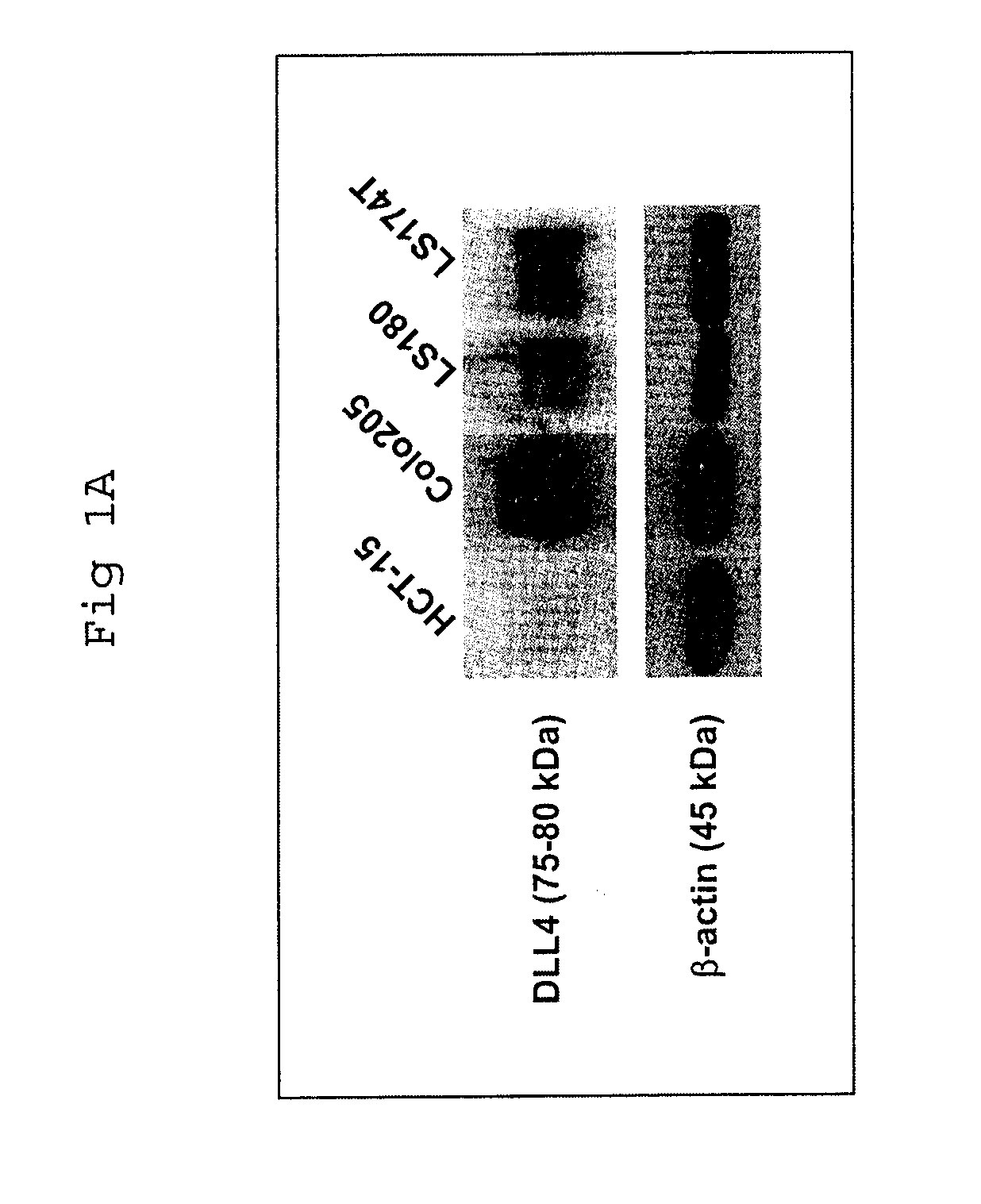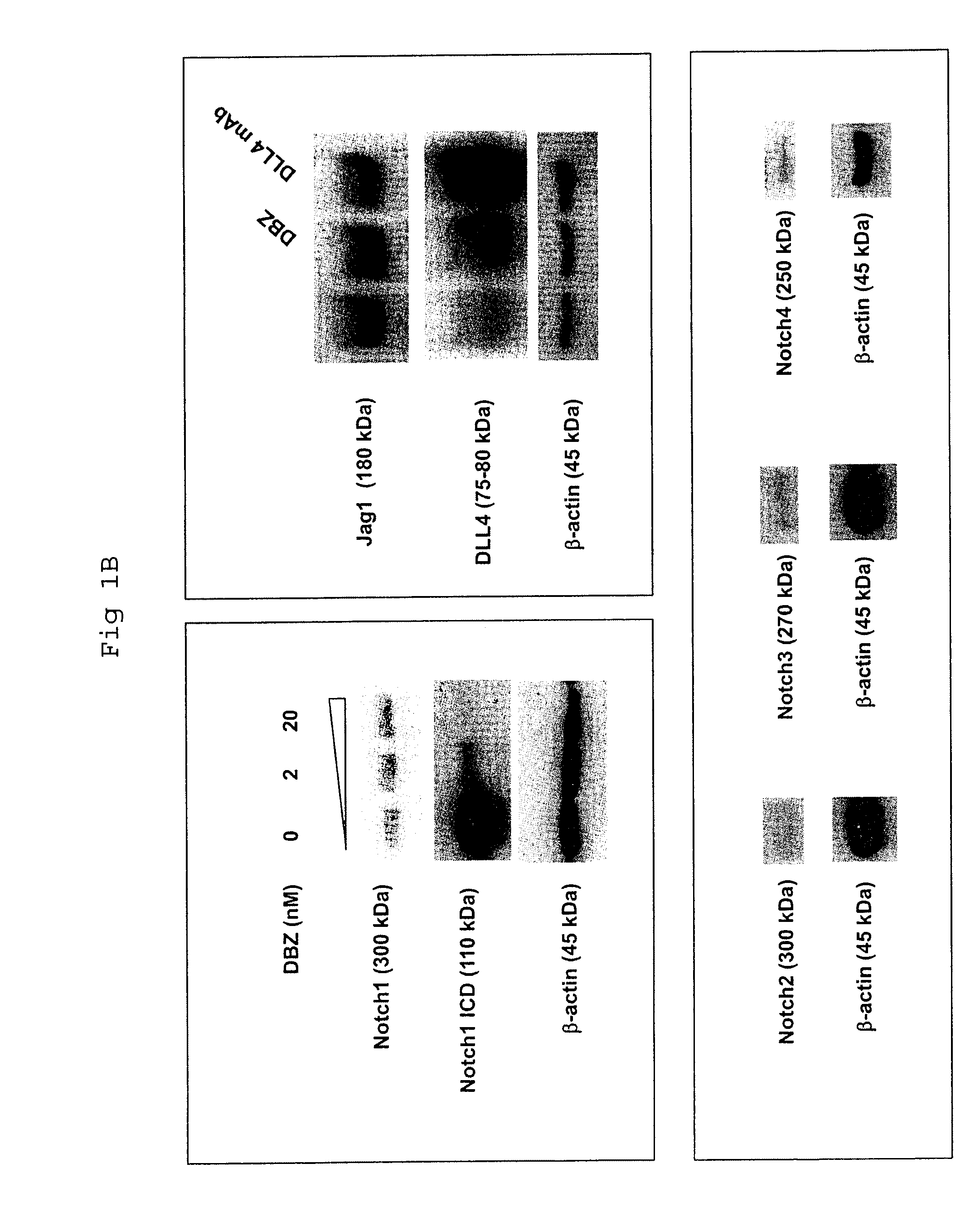Methods of enhancing the response to radiation in tumor therapy using anti-DLL4 antibodies
a technology of anti-dll4 antibody and tumor therapy, which is applied in the field of cancer, tumor and neoplasia treatment, can solve the problems of abnormal vascularity in embryonic lethality, and increased density of poorly functional vessels
- Summary
- Abstract
- Description
- Claims
- Application Information
AI Technical Summary
Benefits of technology
Problems solved by technology
Method used
Image
Examples
example 1
Notch Signaling Inhibitors and Cell Lines
[0145]Notch Signaling Inhibitors
[0146]The production of several anti-DLL4 antibodies is described in detail in US2010 / 0196385, “Targeted Binding Agents Directed to DLL4 and Uses Thereof” by Vehe Bedian, David Jenkins, and Ian Foltz, which also published as WO 2010 / 032060. Each of those publications is incorporated by reference in its entirety. One of those anti-DLL4 antibodies, the human antibody 2A5, was used in the examples that follow (where it is referred to as “DLL4 mAb”), but its use is exemplary only.
[0147]Dibenzazepine (DBZ) is a γ-secretase inhibitor that can be used to block essentially all Notch signaling. However, γ-secretases have a broad range of potential substrates in addition to Notch receptors (Fortini M E, Nat Rev Mol Cell Biol. 2002, 3(9):673-84).
[0148]Cell Lines
[0149]To identify and validate a model colorectal carcinoma cell line for intact Notch signaling, Oncomine was used to screen the Wooster cell line panel for DLL4 ...
example 2
DLL4 is a Major Notch Signaling Ligand
[0150]The colorectal adenocarcinoma lines COLO 205, LS174T, LS180, and HCT-15 were analyzed for expression of DLL4 and other Notch receptors by western blotting. Cells were rinsed once with phosphate-buffered saline, then lysed in ice cold RIPA lysis buffer (50 mM Tris-HCl pH 7.4, 150 mM NaCl, 1 mM EDTA, 1% NP-40, 0.5% sodium deoxycholate, 0.1% sodium dodecyl sulfate) containing COMPLETE™ Protease Inhibitor Cocktail (Roche), and phosphatase inhibitors (1 mM NaF, 2.5 mM sodium pyrophosphate, 1 mM sodium orthovanadate), ultrasonicated for 1 min, and lysates clarified by centrifugation at 16,500 RPM at 4° C. for 10 min. Protein lysate concentration was determined by the Bradford protein assay (Bio-Rad), and 25-30 IIg of lysate denatured in SDS sample buffer (58 mM Tris-HCl, pH 6.8, 1.71% SDS, 0.83% Pmercaptoethanol, glycerol 6%, 0.002% bromophenol blue) at 100° C. for 5 min and proteins electrophoretically resolved on NOVEX™ 4-12% Tris-glycine gels...
example 3
Notch Blockade does not Affect Proliferation or Apoptosis
[0154]Gamma-secretase inhibitors (GSis) have been reported to decrease proliferation of certain tumor cells and to promote apoptosis (Suwanjunee et al., Anticancer Drugs 2008, 19(5):477-86; Efferson et al., Cancer Res. 2010, 70(6):2476-84; Fan X et al., Stem Cells 2009, 28(1):5-16; Rasul et al., Br J Cancer 2009, 100(12):1879-88; Curry et al., Oncogene 2005, 24(42):6333-44). LS174T cells were incubated in triplicates with vehicle, DBZ (20 nM) or DLL4 mAb (1 μg / mL), total number of cells counted after 5 days with a NUCLEOCOUNTER™ NC-100 (ChemoMetec), and divided by the total number of cells counted in the vehicle treated samples to obtain the fold change. The mean and standard errors were plotted. In this case, DBZ decreased proliferation by approximately 25% relative to untreated LS174T cells, however this was not statistically significant (p=0.065) (FIG. 2A). Likewise, DLL4 mAb did not cause a statistically significant reduct...
PUM
| Property | Measurement | Unit |
|---|---|---|
| concentration | aaaaa | aaaaa |
| dissociation constant | aaaaa | aaaaa |
| time | aaaaa | aaaaa |
Abstract
Description
Claims
Application Information
 Login to View More
Login to View More - R&D
- Intellectual Property
- Life Sciences
- Materials
- Tech Scout
- Unparalleled Data Quality
- Higher Quality Content
- 60% Fewer Hallucinations
Browse by: Latest US Patents, China's latest patents, Technical Efficacy Thesaurus, Application Domain, Technology Topic, Popular Technical Reports.
© 2025 PatSnap. All rights reserved.Legal|Privacy policy|Modern Slavery Act Transparency Statement|Sitemap|About US| Contact US: help@patsnap.com



